 Image search results - "fishing" Image search results - "fishing" |
|
|

Trout fishing ponds for customers in warmer months.
|
|

Riverside fishing ponds
|
|

Fishing ponds
|
|

From July 1 to Sept. 23, Arashiyama also has ukai cormorant fishing. Buy your tickets at this booth slightly upstream from Togetsukyo Bridge.
|
|

The ukai cormorant boats operate twice each evening at 7 pm and 8 pm (6:30 pm and 7:30 pm in Sept.). ¥1,800 for adults and ¥900 for kids age 4–12.
|
|

On board a yakata-bune to view ukai cormorant fishing. Fits about 10 people.
|
|

The boats are hitched together.
|
|

Gifu is not the only place where you can see ukai cormorant fishing.
|
|

Ukai cormorant fishing on the river at Arashiyama was quite enjoyable. It's cheaper than in Gifu, and the cormorants passed by maybe 6 times.
|
|

Yakata-bune boat steerer.
|
|
|
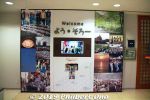
Yo-soro Fishing History Museum, 5 min. by taxi from JR Otsuko Station. Pretty large facility with local fishing-related exhibits. 北茨城市漁業歴史 資料館「よう・そろー」
|
|
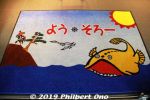
Welcome mat saying "Yo-soro" which means "Go ahead" for boat navigation.
|
|
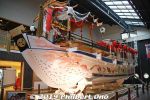
In Kita-Ibaraki, the Yo-soro Fishing History Museum's centerpiece exhibit is this wooden boat (祭事船) used in the Hitachi-Otsu Ofune Matsuri boat festival held every 5 years (常陸大津御船祭り).
|
|
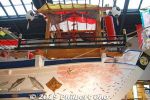
It's the city's grandest festival and very unique because this boat is pulled on city streets instead of sailing on the water.
|
|
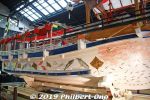
About 500 people drag this boat along a 1,200-meter route of paved streets. They lay wooden beams on the road for the boat to traverse on.
|
|

The boat, with shrine priests and musicians aboard, is rocked side to side as it is dragged on the street for several hours. This festival will be held on May 2nd–3rd, 2019. At least 160,000 spectators are expected to see it.
|
|

The museum also has display panels showing the tsunami damage suffered by Kita-Ibaraki. Ibaraki Prefecture, being on the southern fringe of the Tohoku Region, suffered major earthquake and tsunami damage in March 2011.Kita-Ibaraki being closest to the Tohoku Region on the coast, suffered the most in Ibaraki Prefecture. The flat sandy beaches were overcome by the tsunami (second wave around 5 meters high) that caused much damage to Kita-Ibaraki. This is the Hirakata area after the tsunami. Besides major damage along the coast, the interior areas had numerous landslides, collapsed walls, and damaged roads due to the quake.
|
|

Ten people in Kita-Ibaraki died directly or indirectly due to the tsunami/earthquake and 186 injured. Over 8,000 homes in Kita-Ibaraki were damaged and up to 5,000 people had to evacuate to emergency shelters.These numbers pale in comparison to the three Tohoku prefectures, so Ibaraki doesn't get much attention with regard to 3-11, although the Emperor and Empress did visit Kita-Ibaraki in late April 2011.
|
|
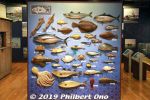
Display of all the fishes caught in Kita-Ibaraki.
|
|
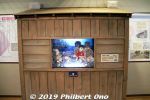
Yo-soro Museum also has this kami-shibai storytelling room. Story about British whalers who landed on Otsuhama beach in Kita-Ibaraki in May 1824 in search of food and water.It was during the time Japan largely prohibited contact with foreigners. By the 1800s, whaling ships from the West were frequently seen off the coast of Japan. In May 1824, multiple British whaling ships appeared off the coast of Kita-Ibaraki.
|
|
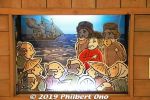
The crew suffered from scurvy due to the lack of vitamin C. They needed water and vegetables so 12 British whalers landed on Otsuhama beach in Kita-Ibaraki. They were willing to barter guns, spears, gold, etc., as payment. (大津浜事件)
|
|
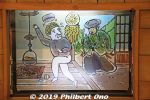
However, the 12 whalers were instead held captive by the local samurai. They were tied to plum trees or confined to caves. More British ships arrived seeking the release of the prisoners.Also, the Mito Clan also brought in neighboring clans like the Taira Clan as reinforcement for a potential battle. Cannons were pointed at each other, but a conflict was averted by giving the whalers the water and food that sent them along their way away from Japan. In return, the whalers gave guns, spears, felt, gold, and silver as payment and had to promise not to approach Japan again.
|
|
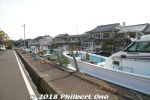
Yoshihara Inlet is a picturesque waterfront fishing neighborhood with boats moored right outside. Fishing village since the Edo Period. Located on the north end of Isazu River (伊佐津川). "Yoshihara" means reed fields, so this area used to have reed beds on marshy land. About 20-min. walk from JR Nishi-Maizuru Station (JR Maizuru Line). Map here
|
|
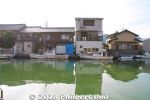
The homes used to have built-in boat garages like at Ine, but they were abolished and the boats are moored right in front instead.
|
|
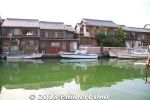
You can just walk along the inlet (be careful not to trip over the boat lines and ropes).
|
|
|
|
|
|
|
|
|
|
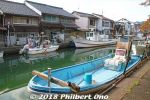
Yoshihara Inlet
|
|
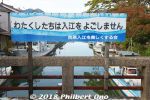
Walk until this bridge going over the inlet. Banner says, "We won't pollute the inlet."
|
|
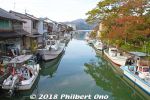
Get some good shots of the inlet from the bridge.
|
|
|
|
|
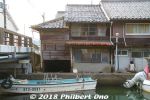
Here's one house that used to have a boat garage connected to the water.
|
|
|
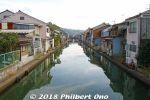
Beyond the bridge, the inlet has no boats.
|
|
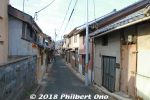
This is the road behind the homes along the inlet.
|
|
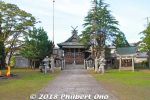
Next to the bridge is this local Shinto shrine named Minazuki Jinja dedicated to Tsukuyomi (月夜見命), the Moon deity and younger brother of Sun Goddess Amaterasu. 水無月神社
|
|
|

The Nagaragawa River ukai cormorant fishing is held nightly from May 11 to Oct. 15 except during the Full Moon and if the river overflows. You can buy tickets and board the viewing boats here, next to Nagarabashi Bridge. 鵜飼観覧船のりば
|
|

Although there is cormorant fishing in other parts of Japan, Gifu's Nagara River ukai cormorant fishing is most famous because it is connected to the Imperial family. Statue of a ukai cormorant fishing master called an "usho." 鵜匠の像
|
|

Ticket office for ukai cormorant fishing viewing boats. Behind it is Nagara River and boat dock. You can buy tickets on the day you want to view the cormorant fishing. Pamphlets in English are available. 鵜飼観覧船事務所
|
|

You have several options: Course/Cruise A is slightly more expensive (3300 yen) than Course B (3000 yen) since it allows you to be on the boat for a longer time. The 6:15 pm departure time is earlier, so it gives you time to eat dinner on the boat.On weekends and holidays, the 3300 yen price is the same for both Course A and B.
|
|

You can bring your own food and drinks on the boat. Next to the ticket office is this stone moument for a TV program which declared a song about Nagara River ukai cormorant fishing to be a national favorite for many years.
|
|

Ukai-related poems. There's even one composed by Basho: おもしろうて やがて悲しき 鵜飼かな。 Gifu's Nagara River ukai cormorant fishing has a 1300-year history. It is recorded in the Nihon Shoki (Chronicle of Japan) and Kojiki
|
|

Boat harbor for ukai viewing boats. The two boats in the foreground are restroom boats. Ukai cormorant fishing is a traditional fishing technique all but replaced by more advanced fishing methods. So it is now mainly for tourists.
|
|

Restroom boat. During the cormorant fishing, this toilet boat is parked near the viewing boats for your convenience.
|
|

Ukai cormorant fishing viewing boat. You don't need to go as a group. You can go by yourself and just ride with other passengers. There are also boats for women only, families only, and couples only.
|
|

If you have a group of 15 or more, it would be cheaper to charter a boat to view the cormorant fishing. Some of the viewing boats are also handicapped-accessible.
|
|

Dancing boat where dancers entertain people before the ukai fishing. 踊り舟
|
|

At the boat dock (next to Nagarabashi Bridge) at 5:45 pm, one of the six ukai cormorant fishing masters give a short talk about ukai fishing. The crowd gathers for the talk.
|
|

Ukai cormorant fishing master Sugiyama Ichisaburo comes to give the ukai talk. The basket has two cormorant birds. Nagara River in Gifu has six ukai cormorant fishing masters. All of them appear nightly. 杉山市三郎
|
|

First he explains about the fishing master's costume, starting with his cap (kazaori-eboshi) made of hemp cloth. It's actually a flat piece of black or navy blue cloth wrapped around his head to protect his hair from the fire. 風折烏帽子
|
|

The cap protrudes upward to make room for the topknot which the men used to have in the old days. His shirt (ryofuku) is made of cotton. He also has a fire-protection vest (muneate) that has a pocket. 漁服(りょうふく)胸あて(むあて)
|
|
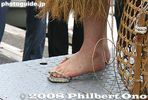
His footwear is a pair of half-slippers (ashinaka) made of straw (handmade by the fishing master). It is half the usual length. It prevents him from slipping on the fish oil and water. 足半(あしなか)
|
|

He took out one of the cormorants from the basket cage. In Japanese, the bird is called umi'u. They normally fish in the ocean as opposed to the kawa'u river cormorant which are smaller and have been devastating to the fish in Lake Biwa.
|
|

He puts in ayu sweetfish into the cormorant's mouth. Nagara River's six cormorant fishing masters are employees of the Imperial Household Agency (Ceremonies Dept.). They are national government employees. 海鵜
|
|

There is a ring around the bird's throat, preventing it from swallowing the fish. (The bird can still swallow smaller fish.) The cormorants are caught in the wild in Hitachi, Ibaraki Prefecture and trained for ukai fishing in Gifu. 鵜
|
|
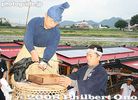
The bird then spits out the fish. The person on the right is the fishing master's son being groomed to take over his father's job. The fishing master has been doing this for 50 years. It is a hereditary position and occupation. 鮎
|
|

The fishing master's handmade skirt (koshimino) is made of straw. It functions as a raincoat and provides warmth. He makes and wears out four or five skirts each year. Underneath is just shorts. 腰蓑(こしみの)
|
|
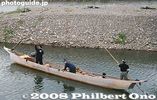
The ukai fishing master's ukai cormorant fishing boat is called ubune. Accompanied by an assistant (middle) called the nakanori and the steerer (at rear) called tomonori. About 13 meters long. 鵜舟(うぶね)= 鵜匠+供乗り(とものり)
|
|

After the ukai talk, passengers start to board the ukai viewing boats at 6:15 pm. Course B passengers will board at 6:45 pm or 7:15 pm. Course B is for people who just want to see the cormorant fishing, and don't care to spend much time on the boat.
|
|

With passengers aboard, the boats depart one after another, heading upstream.
|
|

The viewing boats are called yakata-bune. They come in different sizes. 屋形船
|
|

The smaller yakata-bune, like this one, is human-powered.
|
|

The larger yakata-bune has a silent, battery-powered outboard motor. Notice the solar panels on the roof. 屋形船
|
|

Ukai viewing boats head upstream to where the boats are parked next to the river shore.
|
|

If you're staying at a hotel or ryokan in Gifu city, it's possible to have your hotel arrange the viewing of the cormorant fishing. I went to see ukai cormorant fishing through a luxury hotel on the river. The dock was a short walk from the hotel.
|
|

Mt. Kinkazan, topped with Gifu Castle, is a prominent sight on Nagara River. 金華山
|
|

Ukai viewing boats going upstream with Mt. Kinkazan in the background. The castle is also lit at night.
|
|

Nagara River 長良川
|
|

Boats awaiting passengers. We call them yakata-bune. The roof is shaped like a house roof. 屋形船
|
|

Inside one boat. The floor has tatami mats. A low table is also provided. No dinner provided on this boat.
|
|

This is our ukai viewing boat called Dosan Maru, named after the famous lord of Gifu. All the ukai viewing boats have a name related to the Gifu area, Nagara River or ukai fishing. Notice the bento boxes. 道三丸
|
|

After they took our picture in front of the boat (and later charged 1,000 yen for a 5x7 in. print), we started to board the large boat.
|
|

Nagara River, looking upstream. We departed at about 6:30 pm. 長良川
|
|

Our boat was semi-human powered. I think this guy should be wearing a happi coat and a Chinaman's hat for better atmosphere and aesthetics.
|
|

Mt. Kinkazan
|
|

We approach the parking place along with the other boats already parked next to the river shore.
|
|

We had ordered bento box lunches from the hotel. This kind of cruise probably cost 5,000 yen per person. Smoking is not allowed on the boat.
|
|

Bento box lunch. It was pretty good. We also had a variety of soft drinks. Before the ukai fishing began, we had time to eat dinner.
|
|

Also before the ukai fishing began, this little boat came round to sell beer and fireworks. My relatives, being rich, bought some fireworks for the kids.
|
|

The lanterns in the boat were covered with bugs. Apparently harmless, but it got the girls and women squeamish.
|
|

A neighboring boat shoot some fireworks.
|
|

The light of the fireworks immediately attracted a swarm of bugs which died from the fire and dropped into the river. Stupid bugs.
|
|

The ukai viewing boats are parked like so as they watch the ukai fishing boats pass by.
|
|

The ukai viewing boats were parked right next to shore, so we could easily get out and go on land. We could walk to the toilet boat parked nearby.
|
|

So we finished eating dinner, and at around 7:45 pm, the first ukai cormorant fishing boat passed by. The order in which the fishing masters pass by and fish is decided by drawing lots. The fish catch varies depending on what order you fish.
|
|

The burning torch provides light and attracts the sweetfish. The cormorants dive into the water to catch the fish. The bird then is pulled to the boat to spit out the fish. The ukai cormorant fishing master holds the leash to 10 to 12 birds.
|
|

The torch fire is called kagaribi 篝火, the pine wood used for the fire is called matsuwariki 松割木, and the metal basket holding the burning wood is called kagari 篝. The pole holding the torch is called kagaribo 篝棒.
|
|

The 122 tools (including the cormorant fishing boat) used by the fishing master are Important Tangible Properties. If you want to take pictures, flash and a high ISO speed are essential. Video is great too.
|
|

The cormorants go out on these fishing trips on an empty stomach. They are starving, and therefore motivated to hunt for fish. The six ukai fishing boats pass by, so you get ample chance to take pictures and videos.
|
|

After spitting out its catch, the bird goes back into the water. The title of usho 鵜匠 (cormorant fishing master) was created by Oda Nobunaga. Only the Nagara River ukai fishing masters have this title. Other cormorant fishermen are u-zukai 鵜使い.
|
|

Amazing how the strings don't get tangled. The fishing master can quickly cut the rope in case it gets caught on rock underwater so the bird does not drown. Also see my YouTube video here.
|
|

The usho (cormorant fishing master) and nakanori (assistant). The fishing master has about 20 cormorants at his home. Since they live together, he and the birds are able to work well together. 鵜匠、なか乗り
|
|

For the climax, called sogarami (joint-formation fishing), all six ukai cormorant fishing boats line up and proceed downriver together while they chase the fish to the shallows. 総がらみ
|
|

Sogarami, all six ukai cormorant fishing boats line up and chase the fish downriver together while the fishing masters shout "Hou-Hou." I. Photographing this is difficult since your flash cannot reach the boats. 総がらみ
|
|

The cormorant fishing boats then parked near the viewing boats and showed us how they feed/reward the starving birds with fish and then put back the birds in the basket cages.
|
|

They also showed us a sample of the ayu sweetfish that were caught. These are larger than normal ayu. Those caught by the cormorants are expensive. The fish die quickly in the bird's beak, preserving freshness. You can see the beak marks on the fish.
|
|

Near Nagara River is the homes of the cormorant fishing masters.
|
|

Ukai cormorant fishing boats docked near the cormorant fishing masters' homes. At the right time, you can watch them carry the birds to the boats as they prepare for the ukai fishing.
|
|

Homes of the cormorant fishing masters. It may be possible to see their birds if you ask politely and if they are not busy.
|
|

Sign at one home of a cormorant fishing master. The fishing masters also perform cormorant fishing for the Imperial family 8 times a year at designated areas on Nagara River. The fish is offered to the Imperial family, Ise Shrine, and Meiji Shrine. 御料
|
|

Pine wood stored at one cormorant fishing master's home.
|
|

There is also a small park called the Ukai Hiroba 鵜飼ひろば。
|
|

From this park, you can also watch the nightly ukai fishing on the river.
|
|
|
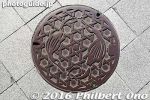
Gifu city manhole showing cormorants
|
|
|
|
|
|
|